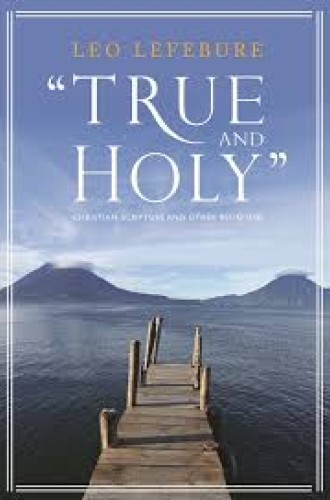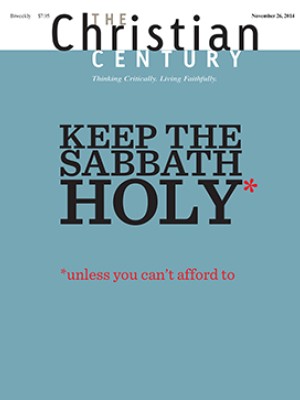True and Holy, by Leo D. Lefebure
Engagement in serious, respectful conversation with other religious traditions is increasingly urgent. Leo Lefebure of Georgetown University details why this engagement is not only urgent but difficult.
The book is primarily a historical report on the vexing attitudes and practices of Christians. Over time, Christians have frequently articulated their faith with absolutist claims and have assessed other great religious traditions by that norm, often with demeaning caricature and stereotype.
Lefebure frames the problem as a hermeneutic of hostility versus a hermeneutic of hospitality. Much of the hostility that has dominated Christian attitudes has been grounded in, or understood to be grounded in, scripture—thus the book’s subtitle. Lefebure urges that it is past time for a hermeneutic of hospitality that takes other religious traditions seriously, respects them, and expects to learn from them.
Read our latest issue or browse back issues.
The book opens with two chapters that define the principles and possibilities for such engagement. Lefebure traces the impulse of respect for other religious traditions that has always been present in Christian teaching, noticing the openness voiced by Origen and Augustine, and in recent times by Hans-Georg Gadamer and Paul Ricoeur, both of whom allow for imaginative possibility and exhibit a capacity to critique their own absolutist claims.
Lefebure writes from a Roman Catholic perspective and judges that the new openings articulated by Vatican Council II are of immense importance for future work. Specifically, the dogmatic constitution Nostra Aetate acknowledged that Christian faith is deeply rooted in Jewish tradition and that Judaism is a continuing tradition of God’s commitment to the chosen people, a status that has not been abrogated. In Lumen Gentium, moreover, the Vatican Council opened a way for new engagement with Muslims. It is impossible to overstate the courage and significance of these statements, notwithstanding the determined efforts by some since the council to undo their impact. Lefebure shows that the council acted against the mainstream of hostility in a way that amounted to repentance on the part of the church.
The core of the book consists of four chapters detailing the history of Christian attitudes and practices toward Judaism, Islam, Hinduism, and Buddhism in turn. The news is not good: the Christian tradition has been dominated by hostility as it has defended its own absolutism and an assumption of its superiority that is often linked to the supposed superiority of Euro-American culture. This hostility is particularly acute and poisonous toward the other book religions, Judaism and Islam, and less so toward the Eastern religions.
Lefebure’s presentation of Christian attitudes toward Judaism is very tough reading because those attitudes are almost unrelievedly hostile, a basis for which is easily found in the New Testament. In the later tradition carefully traced here, the negative view of Judaism is vigorous, including supersessionism and charges of “Christ killer”—a negation repeated by Aquinas and Luther. Later even Schleiermacher and Barth joined the chorus, even though their stances on theological matters might have allowed otherwise. The book does offer emerging evidence of a more hospitable interface in recent times, with reference to Ricoeur, Jürgen Moltmann, Mary Boys, and Sandra Schneiders. Lefebure notes the way in which Christian Zionism has taken a different but equally problematic stance toward Judaism.
The history of Christian attitudes toward Islam is equally distressing and difficult. In Christian tradition, Islam is often taken as a Christian heresy, or Muhammad is seen as a forerunner of the Antichrist. Of course, the Crusades only fed and intensified the negativity. In this case, Lefebure singles out Francis of Assisi for positive notice. For hospitable engagement in recent times he credits Louis Massignon, Thomas Merton, Hans Küng, and Miroslav Volf.
Lefebure reports a different tone concerning Hinduism and Buddhism, with which Christians have attempted to find common ground even though the missionary movement tended to regard Hinduism as idolatry. As might be expected, Gandhi’s presence and influence loom large in Lefebure’s chronicle. Vatican II’s emphasis on inculturation and the urgency of Dalit theology attract important attention.
A viable interface with Buddhism has been much pursued by Christians who have found common ground in the dimension of mystery to which both Christian faith and Buddhism seek to give expression. Among recent interpreters who have sought a generative interface with Buddhism are C. S. Song, Kosuke Koyama, and, again, Merton. Lefebure concludes:
It is a great paradox that even though Buddhists and Christians differ profoundly on fundamental questions of cosmology and anthropology, nevertheless from various perspectives, participants in dialogue have repeatedly discovered resonances that have transformed and enriched their lives.
This careful and detailed account of interactions over time is a unique piece of scholarship. Without doubt, a sharpened awareness of historical hostility is important; there is so much for Christians to unlearn and so much for which to repent.
The conclusion of the book reflects on possible ways forward, but Lefebure keeps expectations low and limited. He suggests that Bernard Lonergan’s proposal of new levels of consciousness may hold promise:
Lonergan’s call for a multilevel intellectual, moral, and religious conversion offers a framework for interpreting the turn away from traditional Christian interpretations of the Bible toward a more respectful, generous approach to the Bible in relation to other religious traditions. At its best Christian theological reflection seeks to understand and be guided by the true, the good, and the beautiful, transcendental notions that are important for other religious traditions as well.
Lefebure rightly critiques René Girard’s one-size-fits-all reductionism, but his focus on Lonergan and Girard in the conclusion is at best disappointing because they are too theoretical. A better reference point might be found in Emmanuel Levinas and his accent on the “face of the other”: new attitudes cannot be arrived at internally, but only with exteriority—in dialogue with the other. It is in engagement with the other, without any grand theory, that hostility may turn to hospitality.
True and Holy is an important opportunity to recover our less than glorious history as Christians. Lefebure’s appeal to Vatican II is an ideal place from which to begin the journey from hostility to hospitality: it was a council of uncommon generosity—exactly the generosity required in a world of alienation, miscommunication, and ideologies that lead to violence.







